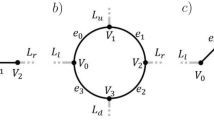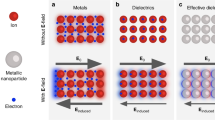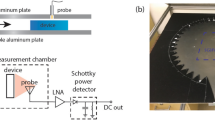Abstract
Balancing complexity and simplicity has played an important role in the development of many fields in science and engineering. One of the well-known and powerful examples of such balance can be found in Boolean algebra and its impact on the birth of digital electronics and the digital information age. The simplicity of using only two numbers, ‘0’ and ‘1’, in a binary system for describing an arbitrary quantity made the fields of digital electronics and digital signal processing powerful and ubiquitous. Here, inspired by the binary concept, we propose to develop the notion of digital metamaterials. Specifically, we investigate how one can synthesize an electromagnetic metamaterial with a desired permittivity, using as building blocks only two elemental materials, which we call ‘metamaterial bits’, with two distinct permittivity functions. We demonstrate, analytically and numerically, how proper spatial mixtures of such metamaterial bits lead to elemental ‘metamaterial bytes’ with effective material parameters that are different from the parameters of the metamaterial bits. We then apply this methodology to several design examples of optical elements, such as digital convex lenses, flat graded-index digital lenses, digital constructs for epsilon-near-zero (ENZ) supercoupling and digital hyperlenses, thus highlighting the power and simplicity of the methodology.
This is a preview of subscription content, access via your institution
Access options
Subscribe to this journal
Receive 12 print issues and online access
$259.00 per year
only $21.58 per issue
Buy this article
- Purchase on Springer Link
- Instant access to full article PDF
Prices may be subject to local taxes which are calculated during checkout




Similar content being viewed by others
References
Cai, W. & Shalaev, V. M. Optical Metamaterials: Fundamentals and Applications (Springer, 2009).
Eleftheriades, G. V. & Balmain, K. G. Negative Refraction Metamaterials: Fundamental Principles and Applications (IEEE-Wiley, 2005).
Engheta, N. & Ziolkowski, R. Electromagnetic Metamaterials: Physics and Engineering Explorations (IEEE-Wiley, 2006).
Smith, D. R., Pendry, J. B. & Wiltshire, M. C. K. Metamaterials and negative refractive index. Science 305, 788–792 (2004).
Engheta, N. Circuits with light at nanoscales: Optical nanocircuits inspired by metamaterials. Science 317, 1698–1702 (2007).
Alu, A., Bilotti, F., Engheta, N. & Vegni, L. Theory and simulations of a conformal omni-directional subwavelength metamaterial leaky-wave antenna. IEEE Trans. Antennas Propag. 55, 1698–1708 (2007).
Alu, A., Engheta, N., Erontuk, A. & Ziolkowski, R. Single-negative, double-negative, and low-index metamaterials and their electromagnetic applications. URSI Radio Sci. Bull. 319, 6–19 (2006).
Jiang, Z. H. et al. Tailoring dispersion for broadband low-loss optical metamaterials using deep-subwavelength inclusions. Sci. Rep. 3, 1571 (2013).
Choi, M. et al. A terahertz metamaterial with unnaturally high refractive index. Nature 470, 369–373 (2011).
Gansel, J. K. et al. Gold helix photonic metamaterial as broadband circular polarizer. Science 325, 1513–1515 (2009).
Soukoulis, C. M. & Wegener, M. Optical metamaterials—more bulky and less lossy. Science 330, 1633–1634 (2010).
Shevchenko, E. V., Talapin, D. V., Kotov, N. A., O’Brien, S. & Murray, C. B. Structural diversity in binary nanoparticle superlattices. Nature 439, 55–59 (2006).
Liu, N., Liu, H., Zhu, S. & Giessen, H. Stereometamaterials. Nature Photon. 3, 157–162 (2009).
Sun, Y., Edwards, B., Alù, A. & Engheta, N. Experimental realization of optical lumped nanocircuits at infrared wavelengths. Nature Mater. 11, 208–212 (2012).
Monticone, F., Estakhri, N. M. & Alù, A. Full control of nanoscale optical transmission with a composite metascreen. Phys. Rev. Lett. 110, 203903 (2013).
Caglayan, H., Hong, S-H., Edwards, B., Kagan, C. R. & Engheta, N. Near-infrared metatronic nanocircuits by design. Phys. Rev. Lett. 111, 073904 (2013).
Milton, G. W. Bounds on the transport and optical properties of a two-component composite material. J. Appl. Phys. 52, 5294–5304 (1981).
Yun, S. et al. Low-loss impedance-matched optical metamaterials with zero-phase delay. ACS Nano 6, 4475–4482 (2012).
Maas, R., Parsons, J., Engheta, N. & Polman, A. Experimental realization of an epsilon-near-zero metamaterial at visible wavelengths. Nature Photon. 7, 907–912 (2013).
Sihvola, A. H. Electromagnetic Mixing Formulas and Applications (IET, 1999).
Chettiar, U. K. & Engheta, N. Internal homogenization: Effective permittivity of a coated sphere. Opt. Express 20, 22976–22986 (2012).
Johnson, P. B. & Christy, R. W. Optical constants of the noble metals. Phys. Rev. B 6, 4370–4379 (1972).
Bass, M. et al. Handbook of Optics (McGraw Hill, 1995).
Smith, D. R., Vier, D. C., Koschny, T. & Soukoulis, C. M. Electromagnetic parameter retrieval from inhomogeneous metamaterials. Phys. Rev. E 71, 036617 (2005).
Salandrino, A. & Engheta, N. Far-field subdiffraction optical microscopy using metamaterial crystals: Theory and simulations. Phys. Rev. B 74, 075103 (2006).
Jacob, Z., Alekseyev, L. V. & Narimanov, E. Optical Hyperlens: Far-field imaging beyond the diffraction limit. Opt. Express 14, 8247–8256 (2006).
Liu, Z., Lee, H., Xiong, Y., Sun, C. & Zhang, X. Far-field optical hyperlens magnifying sub-diffraction-limited objects. Science 315, 1686 (2007).
Silveirinha, M. & Engheta, N. Theory of supercoupling, squeezing wave energy, and field confinement in narrow channels and tight bends using ɛ near-zero metamaterials. Phys. Rev. B 76, 245109 (2007).
Alù, A., Silveirinha, M. & Engheta, N. Transmission-line analysis of ɛ-near-zero–filled narrow channels. Phys. Rev. E 78, 016604 (2008).
Silveirinha, M. & Engheta, N. Tunneling of electromagnetic energy through subwavelength channels and bends using ɛ-near-zero materials. Phys. Rev. Lett. 97, 157403 (2006).
Engheta, N. Pursuing near-zero response. Science 340, 286–287 (2013).
Alù, A. & Engheta, N. Dielectric sensing in ɛ-near-zero narrow waveguide channels. Phys. Rev. B 78, 045102 (2008).
Acknowledgements
This work is supported in part by the US Office of Naval Research (ONR) Multidisciplinary University Research Initiative (MURI) Program, with grant number N00014-10-1-0942.
Author information
Authors and Affiliations
Contributions
C.D.G. carried out analytical modelling, numerical simulations and material-parameter retrieval. N.E., as the principal investigator of the project, conceived the idea, suggested the designs, planned, coordinated and supervised the work. Both authors discussed the theoretical and numerical aspects and interpreted the results. Both authors contributed to the preparation and writing of the manuscript.
Corresponding authors
Ethics declarations
Competing interests
The authors declare no competing financial interests.
Supplementary information
Supplementary Information
Supplementary Information (PDF 1256 kb)
Rights and permissions
About this article
Cite this article
Della Giovampaola, C., Engheta, N. Digital metamaterials. Nature Mater 13, 1115–1121 (2014). https://doi.org/10.1038/nmat4082
Received:
Accepted:
Published:
Issue Date:
DOI: https://doi.org/10.1038/nmat4082
This article is cited by
-
A universal metasurface antenna to manipulate all fundamental characteristics of electromagnetic waves
Nature Communications (2023)
-
Characterization of interaction phenomena of electromagnetic waves with metamaterials via microwave near-field visualization technique
Scientific Reports (2023)
-
Terahertz wavefront engineering using a hard-coded metasurface
Optical and Quantum Electronics (2023)
-
Controlling the transmission angle of terahertz waves based on polarization-sensitive encoded metagrating metamaterials
Optical Review (2023)
-
Reconfigurable chessboard coding plasma-based dielectric resonator structure for RCS reduction
Optical and Quantum Electronics (2023)



